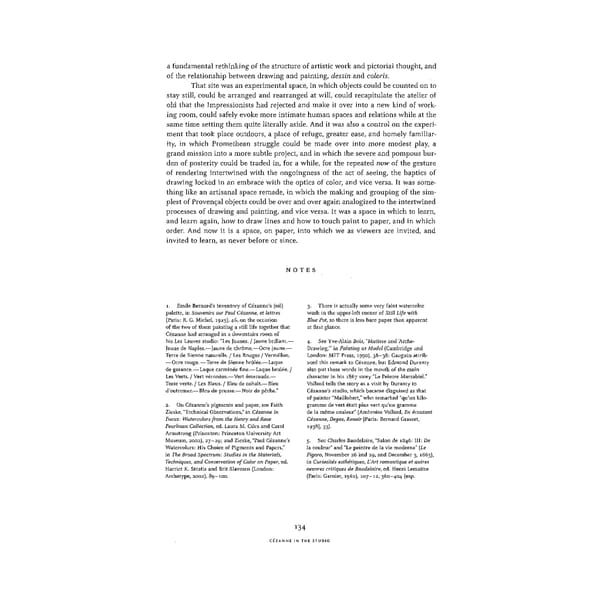a fundamental rethinking of the structure of artistic work and pictorial thought, and of the relationship between drawing and painting, dessin and colons. That site was an experimental space, in which objects could be counted on to stay still, could be arranged and rearranged at will, could recapitulate the atelier of old that the Impressionists had rejected and make it over into a new kind of work- ing room, could safely evoke more intimate human spaces and relations while at the same time setting them quite literally aside. And it was also a control on the experi- ment that took place outdoors, a place of refuge, greater ease, and homely familiar- ity, in which Promethean struggle could be made over into more modest play, a grand mission into a more subtle project, and in which the severe and pompous bur- den of posterity could be traded in, for a while, for the repeated now of the gesture of rendering intertwined with the ongoingness of the act of seeing, the haptics of drawing locked in an embrace with the optics of color, and vice versa. It was some- thing like an artisanal space remade, in which the making and grouping of the sim- plest of Provencal objects could be over and over again analogized to the intertwined processes of drawing and painting, and vice versa. It was a space in which to learn, and learn again, how to draw lines and how to touch paint to paper, and in which order. And now it is a space, on paper, into which we as viewers are invited, and invited to learn, as never before or since. NOTES 1. Emile Bernard's inventory of Cezanne's (oil) 3. There is actually some very faint watercolor palette, in Souvenirs sur Paul Cezanne, et lettres wash in the upper-left corner of Still Life with (Paris: R. G. Michel, 1925), 46, on the occasion Blue Pot, so there is less bare paper than apparent of the two of them painting a still life together that at first glance. Cezanne had arranged in a downstairs room of his Les Lauves studio: "Les Jaunes. / Jaime brillant.— 4. See Yve-Alain Bois, "Matisse and 'Arche- Jaune de Naples.— Jaime de chrome.— Ocre jaune.— Drawing,'" in Painting as Model (Cambridge and Terre de Sienne naturelle. / Les Rouges / Vermilion. London: MIT Press, 1990), 36-38: Gauguin attrib- —Ocre rouge.—Terre de Sienne brulee.—Laque uted this remark to Cezanne, but Edmond Duranty de garance.—Laque carminee fine.—Laque brulee. / also put these words in the mouth of the main Les Verts. / Vert Veronese.—Vert emeraude.— character in his 1867 story "Le Peintre Marsabiel." Terre verte. / Les Bleus. / Bleu de cobalt.— Bleu Vollard tells the story as a visit by Duranty to d'outremer.—Bleu de prusse.— Noir de peche." Cezanne's studio, which became disguised as that of painter "Maillobert," who remarked "qu'un kilo- 2. On Cezanne's pigments and paper, see Faith gramme de vert etait plus vert qu'un gramme Zieske, "Technical Observations," in Cezanne in de la meme couleur" (Ambroise Vollard, En ecoutant Focus: Watercolors from the Henry and Rose Cezanne, Degas, Renoir [Paris: Bernard Grasset, Pearlmari Collection, ed. Laura M. Giles and Carol 1938], 33)- Armstrong (Princeton: Princeton University Art Museum, 2002), 27-29; and Zieske, "Paul Cezanne's 5. See Charles Baudelaire, "Salon de 1846: III: De Watercolors: His Choice of Pigments and Papers," la couleur" and "Le peintre de la vie moderne" (Le in The Broad Spectrum: Studies in the Materials, Figaro, November 26 and 29, and December 3, 1863), Techniques, and Conservation of Color on Paper, ed. in Curiosites esthetiques, L'Art romantique et autres Harriet K. Stratis and Brit Slavesen (London: oeuvres critiques de Baudelaire, ed. Henri Lemaitre Archetype, 2002), 89-100. (Paris: Gamier, 1962), 107-12, 360-404 (esp. 134 CEZANNE IN THE STUDIO
 Cézanne in the Studio: Still Life in Watercolors Page 148 Page 150
Cézanne in the Studio: Still Life in Watercolors Page 148 Page 150